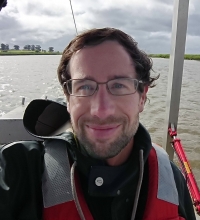Delta Science Fellowship 2017-19
Fellow: Malte Willmes, Postdoctoral Fellow, University of California, Davis
Research mentor: James A. Hobbs, Wildlife, Fish & Conservation Biology, University of California, Davis
Community mentors: Randall Baxter, CA Department of Fish and Wildlife, Louise Conrad, CA Department of Water Resources, & Carol Kendall, United States Geologic Survey
Background
California’s climate is marked prolonged periods of drought alternating with years of heavy precipitation and flood events. Extensive water infrastructure has been built to support a $36 billion agricultural industry, and an urban sector exceeding 25 million people. The Sacramento-San Joaquin Bay-Delta (Delta) forms a vital link in California’s water supply but is also home to several species of endangered native Californian fish, causing significant conflict over the use of the limited fresh water resources for human and environmental flows.
The endangered delta smelt (Hypomesus transpacificus) is at the center of this conflict. Over the next century, warming water temperatures will bring major changes to current habitat conditions, further threatening the resilience of delta smelt and limiting our ability to recover the species.
Project
The inner ear bones of fish, or otoliths, grow continuously and their chemistry reflects the water conditions that a fish has experienced throughout its life. In this project, researchers used in-situ chemical analysis to determine the oxygen isotopic composition of otoliths, which can reflect the water temperature that a fish has experienced. They applied this method to archived adult Delta Smelt otoliths from multiple different water years spanning the time from before and during the recent drought. Using these data, they investigated the relationship between delta smelt abundance and environmental parameters, such as water temperature. More specifically they investigated whether delta smelt are able to find temperature refuges, even in drought years.
Progress/Results
This project started out with validation experiments, in which fellow Malte Willmes analyzed delta smelt reared and kept at four different known temperature and salinity conditions at UC Davis. This was possible through a collaboration with Brittany Davis, a 2016 Delta Science Fellow. Using cutting-edge analytical equipment, the researchers were able to reconstruct detailed temperature and salinity life histories. To apply this tool to wild Delta Smelt they also needed to establish the variation in oxygen and strontium isotope ratios throughout the San Francisco Estuary in response to changes in salinity and water temperature. Together with collaborators in the state and federal agencies they collected and analyzed water samples throughout the estuary in 2018, to create a baseline map of salinity and water temperature.
The next step is to use this baseline map to trace the movement and temperature exposure of wild fish caught in 2011 and 2014 to contrast the effect of different environmental conditions on life histories strategies.
Management Applications
This project will provide detailed thermal life histories for Delta Smelt for the first time and can illuminate thermal habitat requirements for this endangered fish species. These data are critical to predict the effect of future management decisions including habitat restoration, alternative water conveyance, and climate change responses.
The research will be used by the Interagency Ecological Program (IEP), which includes nine state and federal agency partners, to understand which habitat conditions Delta Smelt can utilize in different water years, and in turn help researchers and resource managers to better manage the limited water resources of California for both fish and people.
Publications and Presentations
Willmes M, Ransom KM, Lewis LS, Denney CT, Glessner JJG, Hobbs JA (2018). IsoFishR: An application for reproducible data reduction and analysis of strontium isotope ratios (87Sr/86Sr) obtained via laser-ablation MC-ICP-MS. PLOS One, 13, 9. doi:10.1371/journal.pone.0204519.
Willmes M, Lewis LS, Davis BE, Loiselle L, Hames HF, Denny C, Baxter R, Conrad JL, Fangue NA, Hung TC, Armstrong RA, Williams IS, Holden P, Hobbs JA (2019). Calibrating temperature reconstructions from fish otolith oxygen isotope analysis for California’s critically-endangered Delta Smelt. Rapid Communications in Mass Spectrometry. doi:10.1002/rcm.8464
Willmes M (2018). Validating Thermal Life History Reconstructions from Otolith Oxygen Isotope Analyses of California’s Critically Endangered Delta Smelt. 148th Annual Meeting of the American Fisheries Society. Atlantic City, NJ. August 2018.
Willmes M (2019). Isoscapes in a dynamic system: Advancing tools to reconstruct salinity and temperature life histories of fishes in the San Francisco Estuary. Interagency Ecological Program Workshop. Folsom, CA. April 2019.
Attachments
 Malte Willmes
Malte Willmes
